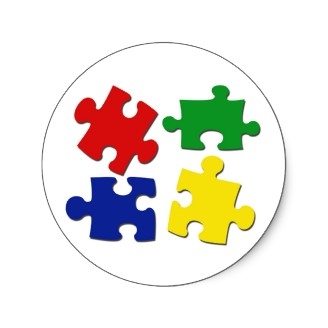Deconstructing Your Complex Problem
Saturday, April 12, 2014

Taking something apart to see how it works, isn't exactly a novel idea. In fact, I'm sure you can think of many times when you've used this method to figure out things.
I think it's a rather intuitive response when it comes to figuring out things. But for some reason, when it comes to figuring out our most difficult problems, this is not our natural first instinct. In fact, we may not even recognize that we should be using this method to solve our problems in the first place.
As with a lot of the ideas I present here, when faced with simple problems we just seem go on autopilot and our problems get solved without much heavy thinking. We're seemingly unaware of the truly complex mental processes that are really going on below our level of awareness. That's because these cognitive processes have been so ingrained in our thinking (and they happen so fast) that they appear to be almost automatic.
But when we're faced with a really difficult problem, we freeze, like some deer that appears in our headlights in the middle of the night. I'll explain why I think this happens to us in a minute. But I can tell you that you should keep using the same methods that have worked for you your whole life ... but with a new twist.
Deliberate Thinking

The key point to contrast here is that when you're solving a really complex problem these cognitive processes are not going to work automatically for you. You're going to have to slow down and deliberately think about how to put these problem solving processes into practice.
When you're solving simple problems, your neurons travel at the speed of light down the same old neural pathways. Over time, these neural pathways have become your dominant way of thinking. They've been burned into your brain to the point where your thinking appears to be automatic.

Now you're faced with a really difficult problem and your automatic thinking just can't handle the complexity of your new problem. Don't give up! Recognize why this is happening to you, then just slow your thinking down a little bit. Take it one-step-at-a-time and deliberately think your way though it.
Hey, I know it's no fun getting out of the fast lane but you may need to slow down your thinking a bit if you're going to take that exit that gets you where you really want to go.
Decomposition Process
Breaking your problem down into it's component parts can be viewed as a three-part process. First, you need to identify all the parts of your problem. Next, you should analyze each part, so you completely understand it's significance (as it relates to your problem). Then, you can use your cognitive skills to develop a logical structure that fits all your parts into a cohesive whole.
Identifying All Your Factors
First, you need to identify all the parts of your problem. Look at every factor, part, component, feature, attribute, property, trait, quality, aspect, characteristic, facet, issue, subject, element, event, source, cause, effect, and action related to your problem.
I usually start by creating a master list of all the factors. At this point, I'm not too concern with ordering them. I'm just making sure that I write every single one of them down. I'll keep adding to this list as I learn more about my problem.

I like to use the analogy of a puzzle for this initial phase. Before you begin putting a puzzle together, you should make sure you have all the pieces of the puzzle out on the table. You wouldn't want to leave any in the box or leave some pieces on the floor? It's the same idea here. Identify all the items that need to be considered in your analysis; before you start analyzing.
Part of this initial process, of gathering all your factors together, touches on the concept of scoping your problem. What are the boundaries of your problem? Looking at all of the parts of your problem should help you determine the boundaries.
You need to look at your factors from the viewpoint of completeness, too. Are there any major gaps? Do you see any areas with lots of uncertainty? This may help you prioritize your research efforts.
I also think you may want to pay particular attention to any unexpected or unusual factors. Look for these as you create your list and make a note of them. You'll be glad you did.
You can use my Factors tool to get started.
Sorting & Grouping
Sorting may be the most underrated process in problem solving.
Sorting and grouping is where you really begin building your structure. And if I believe in anything, it's that structure is the key to solving problems.
Now all you need is a system for structuring your problem. That's where sorting and grouping come in. They can help you create different ways for describing your data.
Data does not describe itself. Data needs to be described and organized to be used efficiently and effectively.
To get help with your sorting efforts, try using my Sorting tool.
Major Categories
The first structural element you'll use to describe your data are major categories. The idea is pretty simple. You just break your problem down into its major component parts. Your goal here is to identify all of your major categories.

Major categories should be:
- Clearly defined,
- Mutually exclusive, and
- Collectively exhaustive.
Defining your major categories may seem like an easy task but you need to take your time here and think this all the way through. Keep in mind that you must have a place to put all of your data. No extra pieces of data can be left out. Especially, those that don't fit neatly into your preconceived view of the world. Also, remember that your major categories can help determine the scope of your analysis.
Your major categories are the foundation that the rest of your problem-solving structure will be built upon. For complex problems, you may have multiple levels of sub-categories that form a hierarchical structure of your problem.
For help to decompose your problem into its major factors, use our Major Categories tool in our Toolkit section.
Interrogatory Dimensions
Using interrogatory words can be a good way group your factors.

Asking key questions is one of the most important techniques you can use to explore the different dimensions of your problem. It just makes sense that finding the right questions will give you a better understanding of your problem and get you closer to the answers that will eventually solve your problem. As you go through the problem-solving process keep track of your key questions. To help you get started, I've developed several lists of generic questions: Who, What, When, Where, Why, How, From Where, To Where, and the Phoenix Checklist. Review the lists of generic questions and pick out the ones that you consider to be key questions for your situation. Of course, the questions you think of on your own could be the best questions of all.
Relationships Between the Parts of Your Problem
You should also analyze your data by searching for relationships, looking for comparisons, and creating visual representations.
You can look at dependencies between your data as a way to group your factors. These are typically cause and effect relationships.
In my previous blog post, I discussed how you can use analogies to help you solve your problems. This method can help you compare your data for similarities and differences.

The relationships between your factors are important. Examples of relationships can be seen in: groupings, cause & effect, variable dependencies, sequences, correlations, analogies, and similarities & differences.
A good way to understand your relationships is to create visual representations of your data structure. Use my Mind Mapping tool to get started.
You're the Most Important Part

I don't know you. But I know you're the most important factor in solving your problems.
You - the problem solver - are the reason I created this website, write this blog, and rack my brain for ways to show you how much power you really have to solve your problems.
You may think that's just a bunch of hot air. Yeah, there was a time that I thought that way, too. It was a time when I was just twisting in the wind. A victim of my own circumstances.
I found a better life. A life where I was not defined by my problems, but by my ability to solve them.
As a man much wiser than I once wrote:
"You are braver than you believe,"
"You are stronger than you seem, and"
"You are smarter than think."
Les Westrum, RIP 2005 from A.A. Milne (Christopher Robin to Winnie the Pooh)
by Keith Glein, Founder & CEO
